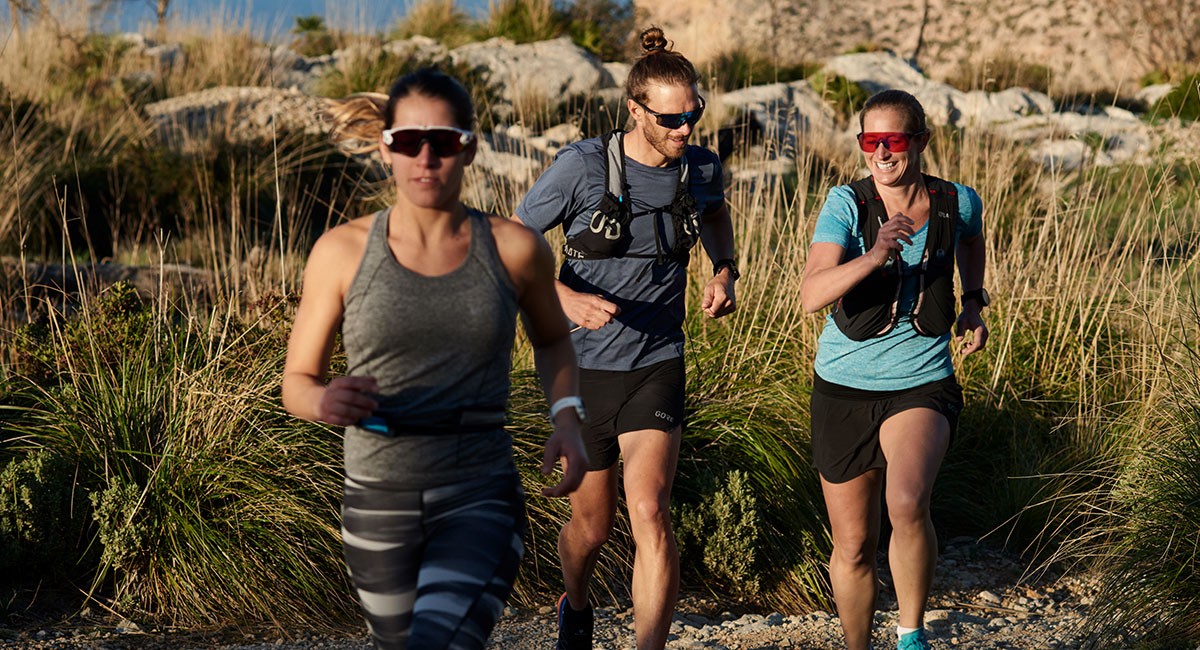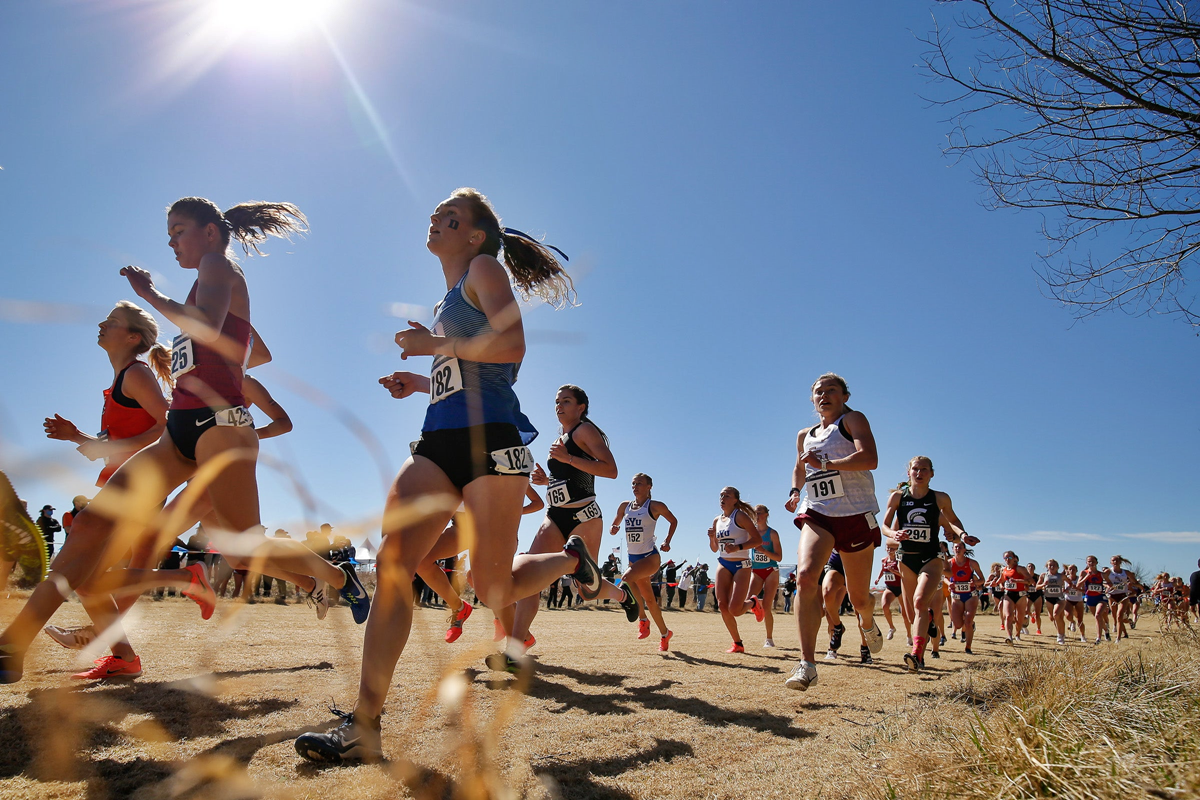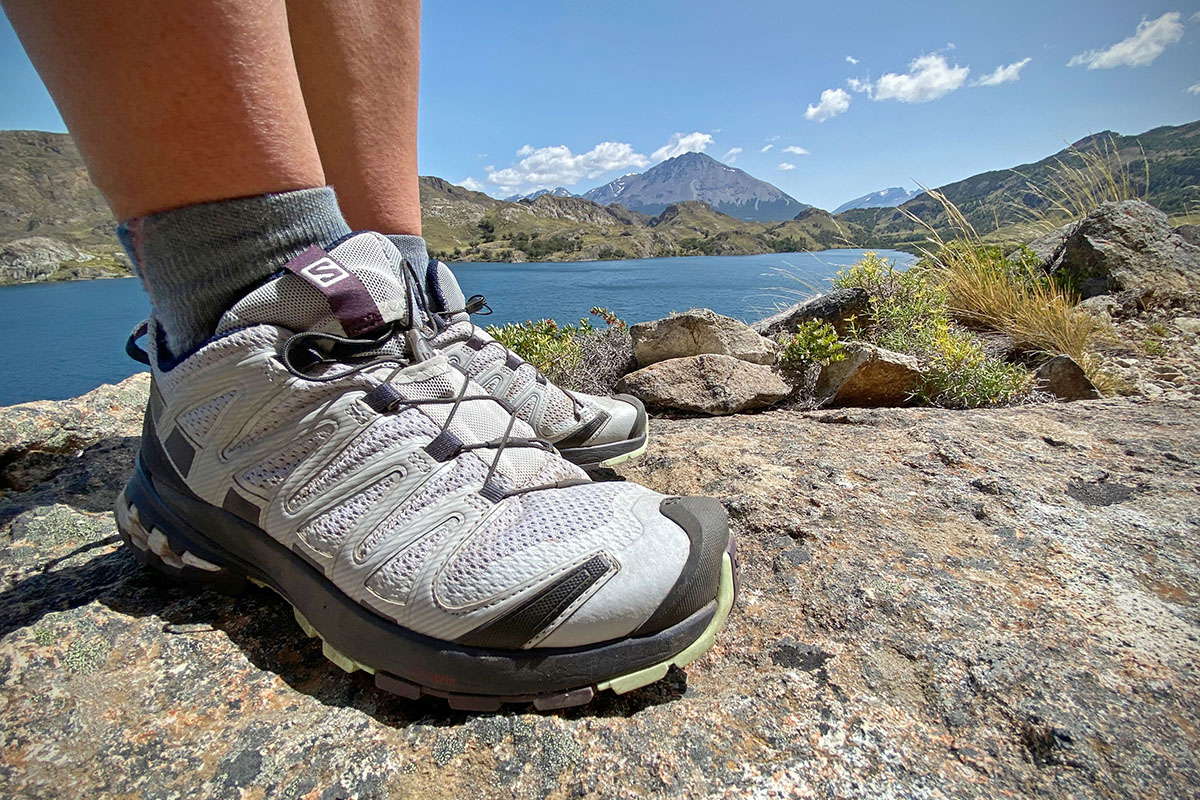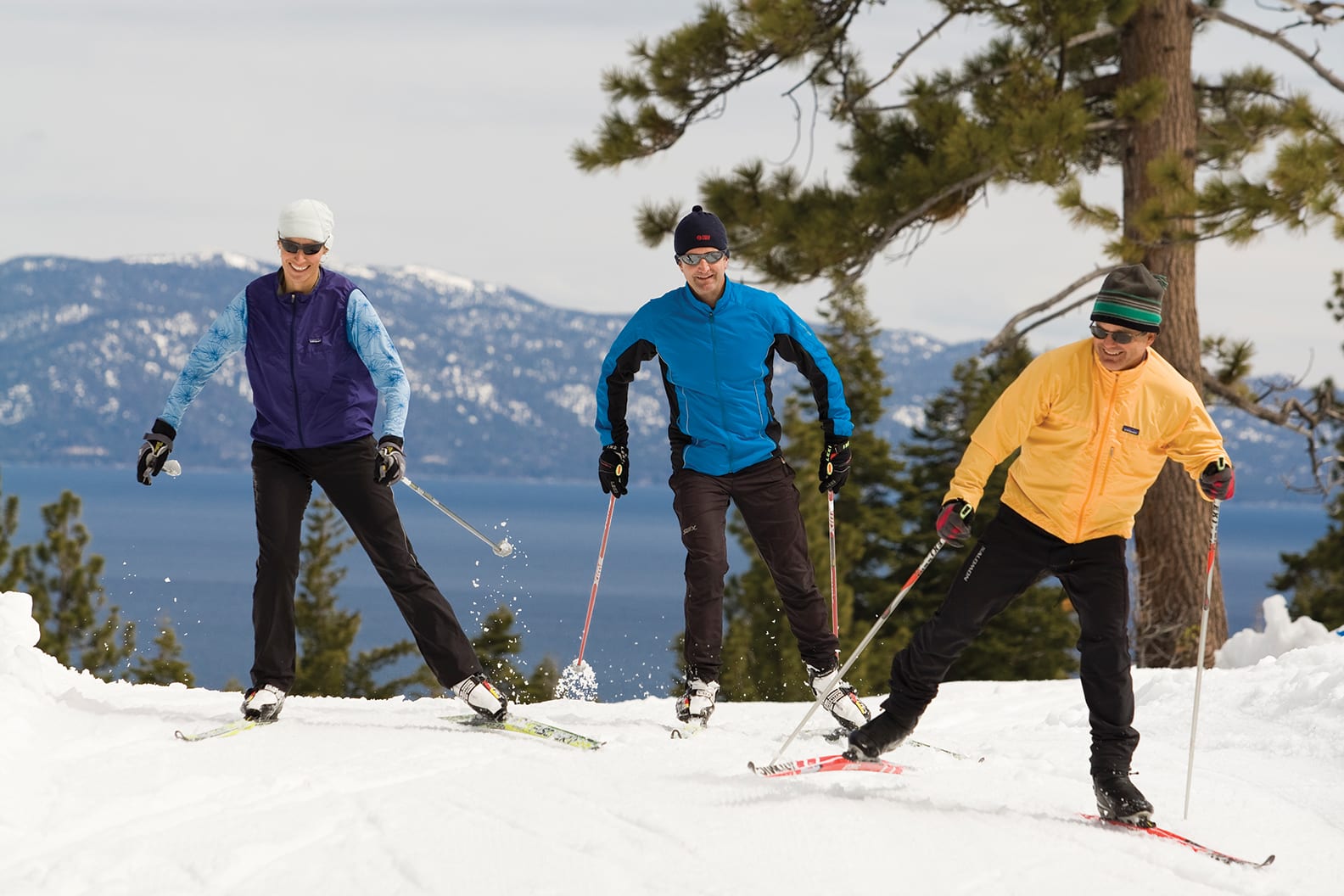

Featured
Why Trail Running
Modified: January 22, 2024
Discover the thrill of trail running with our featured articles. Explore tips, techniques, and gear recommendations to elevate your outdoor adventures.
Introduction
Trail running is a thrilling and exhilarating outdoor activity that combines the joy of running with the beauty of nature. Unlike traditional road running, trail running takes place on off-road paths, often through forests, mountains, and scenic landscapes. It offers a unique experience that not only challenges your physical limits but also provides numerous benefits for both body and mind.
As humans, we have an innate connection with nature, and trail running allows us to tap into that primal instinct. The unpredictable terrain, the fresh air, and the breathtaking views all contribute to a sense of adventure and exploration. In this fast-paced world, trail running acts as an escape, a way to disconnect from technology and immerse ourselves in the tranquility of the natural environment.
But trail running is not just about the scenery; it is also a physically demanding activity that engages different muscles and requires a higher level of endurance. The uneven terrain, inclines, and obstacles force our bodies to adapt and become stronger. From improved cardiovascular fitness to increased muscle strength and flexibility, the physical benefits of trail running are undeniable.
However, the rewards of trail running go beyond just physical fitness. Running through nature has a profound effect on our mental well-being. The peacefulness and serenity of the surroundings have a calming effect on our minds, reducing stress, anxiety, and depression. Research has shown that spending time in nature can improve cognitive function, boost creativity, and enhance overall mental clarity.
Additionally, trail running provides a sense of freedom and liberation, enabling us to break free from the monotony of everyday life and experience a sense of adventure. Each trail offers its own challenges and rewards, from steep ascents to technical descents, rocky paths to muddy tracks. It pushes us to push our boundaries, both physically and mentally, and helps us discover what we are truly capable of.
In this article, we will explore the many benefits of trail running, both physical and mental. We will also provide valuable insights into staying safe on the trails, essential gear for trail running, and training tips to help you get started on this incredible adventure.
Benefits of Trail Running
Trail running offers a plethora of benefits for both our physical and mental well-being. Let’s dive into some of the key advantages:
Physical Benefits
Trail running is a fantastic cardiovascular workout that helps improve heart health and stamina. The varied terrain and constant changes in elevation engage different muscle groups, including those in the legs, core, and upper body, resulting in enhanced strength and endurance.
Compared to running on pavement, the soft and uneven surfaces of trail running reduce the impact on joints, reducing the risk of injuries such as shin splints and stress fractures. This makes trail running a more sustainable and joint-friendly exercise option.
Additionally, the changing landscapes and natural obstacles require greater agility, coordination, and balance, making trail running an excellent exercise for overall physical fitness.
Mental Benefits
Trail running has a profound effect on our mental well-being. The combination of being in nature and engaging in physical activity triggers the release of endorphins, our body’s natural mood boosters. This helps reduce stress, anxiety, and depression, promoting a positive state of mind.
The calm and quiet surroundings of the trails provide a therapeutic escape from the noise and distractions of daily life, allowing us to focus on the present moment and cultivate mindfulness. This mental clarity can lead to increased creativity and improved problem-solving abilities.
Furthermore, trail running provides a sense of accomplishment and self-confidence as we conquer challenging terrains and surpass our limits. The mental resilience and determination developed through trail running can spill over into other areas of our lives, empowering us to overcome obstacles and achieve goals beyond the trails.
Connection with Nature
One of the most rewarding aspects of trail running is the deep connection with nature. The serene surroundings, fresh air, and stunning landscapes provide a profound sense of peace and harmony. Running through forests, mountains, and pristine trails allows us to fully appreciate the beauty and wonders of the natural world.
This connection with nature not only revitalizes our spirits but also serves as a reminder of our place in the larger ecosystem. It cultivates a sense of environmental stewardship and encourages us to protect and conserve the natural resources and habitats that we are privileged to experience through trail running.
Exploration and Adventure
Trail running is an avenue for exploration and adventure. As we venture off the beaten path, each trail becomes a new and exciting playground. The sense of discovery and anticipation fuels our thirst for adventure, and we are constantly rewarded with hidden gems, breathtaking views, and unique encounters with wildlife.
Whether it’s discovering a hidden waterfall, summiting a breathtaking peak, or traversing a challenging ridge, trail running continuously offers new experiences and keeps our sense of wonder alive.
Join us for the next section, where we will explore the challenges and rewards of trail running!
Physical Benefits
Trail running is a physically demanding activity that provides a wide range of benefits for our bodies. From improved cardiovascular fitness to increased strength and endurance, trail running offers a fantastic workout that engages different muscle groups and challenges our physical limits.
Cardiovascular Fitness
Trail running is an excellent cardiovascular exercise that gets your heart pumping and blood flowing. The varied terrain, with its inclines, declines, and uneven surfaces, forces your heart to work harder than traditional road running. This constant change in intensity provides a great aerobic workout, improving your cardiovascular fitness and overall heart health.
Muscle Strength and Endurance
Trail running engages a variety of muscles throughout your body. The uneven terrain and natural obstacles require greater lower body strength, especially in your quadriceps, hamstrings, calves, and glutes. Running on trails also engages your core and upper body muscles as you navigate rough terrains, helping to improve your overall strength and stability.
Endurance is also a crucial aspect of trail running. The constant changes in elevation and varying surfaces challenge your endurance, promoting greater stamina and resistance to fatigue during longer runs. This increased endurance can benefit you not only in trail running but also in other physical activities and daily life.
Joint Health
One of the advantages of trail running over road running is the reduced impact on your joints. The softer surfaces of trails, such as dirt, grass, or forest paths, provide a more forgiving impact compared to hard pavement. This lower impact helps to protect your joints, reducing the risk of injuries such as shin splints and stress fractures, and making trail running a more sustainable exercise option.
Balance and Coordination
Trail running requires more agility, balance, and coordination compared to road running. The varied terrain, with its roots, rocks, and uneven surfaces, forces you to constantly adjust your stride and foot placement. This constant adaptation improves your proprioception, which is your body’s ability to sense the position and movement of your limbs, leading to better balance and coordination.
Weight Management
Trail running is an effective way to burn calories and manage your weight. The combination of cardiovascular exercise and the extra effort required to navigate uneven terrains and inclines increases the number of calories burned during a trail run compared to a typical road run. This can contribute to weight loss or weight management goals when combined with a healthy diet and lifestyle.
Overall, the physical benefits of trail running are vast. It not only helps you improve your cardiovascular fitness, muscle strength, and endurance but also promotes joint health, balance, and coordination. So, grab your trail shoes and reap the rewards of this challenging and rewarding activity!
Mental Benefits
Trail running not only provides physical benefits but also offers numerous mental advantages. The combination of being in nature, engaging in physical activity, and challenging oneself mentally contributes to improved mental well-being and overall happiness.
Stress Relief
Engaging in trail running allows you to escape the pressures and stresses of everyday life. Running in natural surroundings, away from the noise and distractions of technology and urban environments, provides a calming and therapeutic experience. The peacefulness of the trails helps to reduce stress levels, promoting relaxation and a sense of tranquility.
The rhythmic movement of running, coupled with the release of endorphins, helps to alleviate anxiety and tension. The deeper breathing and increased oxygen intake during trail running also contribute to stress reduction and the promotion of a calm state of mind.
Mood Enhancement
Trail running is known to have a positive impact on mood. The release of endorphins during exercise acts as a natural mood booster, promoting feelings of happiness and well-being. The combination of physical activity, being in nature, and achieving personal goals while running trails contributes to a sense of accomplishment and self-confidence, which further enhances mood and self-esteem.
Running in natural surroundings also provides a change of scenery and a break from the monotony of daily life. The opportunity to explore new trails, encounter wildlife, and witness breathtaking landscapes adds excitement and adventure to the running experience, resulting in an elevated mood.
Mental Clarity and Focus
Trail running not only helps to clear the mind but also improves mental clarity and focus. Being in nature allows for a break from distractions and encourages mindfulness. Focusing on the present moment, the feel of the trail beneath your feet, and the sounds and sights of nature helps to reduce mental clutter and improve concentration.
Trail running provides an escape from the constant stimulation of technology and screens, allowing you to disconnect and experience a state of flow. This can lead to increased creativity, improved problem-solving abilities, and enhanced cognitive function in other areas of life.
Strengthened Resilience and Emotional Well-being
The challenges and obstacles encountered during trail running help develop mental resilience. Pushing yourself through difficult terrains, overcoming physical and mental barriers, and persevering during moments of fatigue or discomfort builds tenacity and emotional strength.
This newfound resilience can translate into other areas of life, helping you overcome challenges and setbacks with a more positive mindset. The sense of accomplishment and empowerment experienced through trail running translates into increased self-confidence and emotional well-being.
The mental benefits of trail running are substantial. From stress relief and mood enhancement to improved focus and emotional well-being, trail running provides a holistic approach to promoting mental health and overall happiness.
Connection with Nature
Trail running offers a unique opportunity to connect with nature on a deep and meaningful level. It allows us to experience the beauty of the natural world firsthand, fostering a sense of appreciation, wonder, and environmental consciousness.
Serenity and Tranquility
Running through natural landscapes immerses us in a serene and tranquil environment. The sights, sounds, and smells of the outdoors create a sensory experience that calms the mind and rejuvenates the spirit. The peacefulness of the trails provides an escape from the hectic pace of daily life, allowing us to slow down, breathe deeply, and find solace in nature.
Reconnect with the Earth
Trail running allows us to reconnect with the earth in a profound way. The soft and forgiving surfaces of dirt paths or trails covered with fallen leaves provide a stark contrast to the hard concrete of city streets. Running barefoot or with minimal footwear on the trails enables us to feel the earth beneath our feet, connecting us to the natural world and grounding us in the present moment.
Appreciation for Biodiversity
Trail running exposes us to the incredible biodiversity that exists in our natural surroundings. Running through forests, mountains, or coastal trails, we encounter a wide variety of flora and fauna. Observing wildflowers in bloom, hearing the songs of birds, or catching glimpses of wildlife creates a sense of awe and appreciation for the interconnectedness of all living things.
As we witness the intricate web of life while running on the trails, we become more aware of the importance of conservation and sustainable practices. Trail running can inspire us to become advocates for protecting and preserving these fragile ecosystems for future generations.
Environmental Stewardship
Trail running fosters a sense of responsibility towards the environment. The trail running community often emphasizes Leave No Trace principles, which encourage minimizing our impact on nature while enjoying the trails. Respecting wildlife, properly disposing of waste, and staying on designated paths are all ways in which trail runners can show their commitment to environmental stewardship.
By participating in trail running, we become ambassadors for the natural world. Our experiences on the trails create a deep appreciation for the beauty and fragility of nature, inspiring us to take action and make sustainable choices in our daily lives.
Escape and Renewal
Trail running provides a much-needed escape from the confines of urban living and allows us to connect with our primal selves. It reminds us of our innate connection with the natural world and the importance of spending time outdoors. The renewal and rejuvenation that trail running offers can have a transformative effect on our physical, mental, and emotional well-being.
So lace up your trail shoes, embrace the beauty of the outdoors, and allow trail running to deepen your connection with nature. Let the trails be your guide as you embark on a journey of discovery, appreciation, and environmental stewardship.
Exploration and Adventure
Trail running is not just a form of exercise; it is an exhilarating adventure that invites us to explore new places, push our boundaries, and experience the thrill of discovering nature’s hidden gems.
Uncharted Territory
The trails offer endless possibilities for exploration and discovery. Every trail is unique, with its own set of challenges and surprises. Whether you’re navigating through dense forests, climbing steep inclines, or descending treacherous descents, trail running takes you off the beaten path and into uncharted territory.
Exploring new trails allows us to see the world from a different perspective. It encourages us to venture beyond our comfort zones and embrace the unknown. Each run becomes an opportunity for adventure, a chance to uncover new landscapes, breathtaking vistas, and unexpected wonders.
Breath-Taking Views
Trail running allows us to witness some of Mother Nature’s most awe-inspiring landscapes. From stunning mountain peaks and cascading waterfalls to tranquil lakes and panoramic vistas, the trails offer a front-row seat to the beauty of the natural world.
Running amongst such captivating beauty not only fuels our sense of adventure but also provides a source of inspiration and motivation. The allure of reaching the next vista or discovering what lies around the next bend in the trail becomes a driving force as we embark on our running journey.
Wildlife Encounters
Trail running takes us directly into the habitats of various wildlife species. As we navigate through forests, meadows, and wilderness areas, we have the opportunity to encounter animals such as deer, squirrels, or even rare bird species that call these trails home.
These encounters act as a reminder of the delicate balance of nature and our role in preserving it. Observing these creatures in their natural habitats adds an element of excitement and curiosity to our runs, keeping us connected to the natural world and deepening our appreciation for the intricate web of life.
A Sense of Freedom
Trail running provides a sense of freedom and liberation that is hard to replicate in other forms of exercise. The trails offer an escape from the constraints of road running or indoor workouts. Running amidst nature’s beauty creates a feeling of being one with the environment, where the worries and stresses of everyday life fade away.
The trails become our playground, where we can run, jump, and explore without limitations. With each stride, we revel in the sense of freedom that comes with conquering new terrains and conquering our own self-imposed limitations.
Adventure for All Levels
Trail running is for everyone, regardless of fitness level or experience. From novice runners seeking a change of scenery to seasoned ultramarathoners tackling challenging mountain trails, there is an adventure waiting for everyone on the trails.
Whether you’re looking for a short and scenic trail or a multi-day, epic adventure, the trail running community offers a wealth of knowledge and resources to help you find your perfect trail. Joining local running groups or participating in trail running events can introduce you to fellow adventurers and provide a supportive network as you embark on your own trail running journey.
So, put on your trail running shoes, grab your sense of adventure, and set out to explore the beauty and excitement that trail running has to offer. Discover new landscapes, witness breathtaking views, and feel the exhilaration of venturing into the unknown. The trails are waiting, ready to unleash the explorer within you.
Challenges and Rewards
Trail running presents a unique set of challenges that test our physical and mental limits. However, the rewards of conquering these challenges are immeasurable, making trail running an incredibly fulfilling and gratifying endeavor.
Physical Challenges
Trail running pushes us to adapt and conquer varying terrains and elevation changes. The uneven surfaces, rocky paths, and technical descents demand a high level of agility, balance, and endurance. Each run presents a new set of physical challenges, from steep ascents that test our leg strength to technical descents that require precise footwork.
Running on trails engages different muscle groups, providing a more well-rounded workout compared to road running. The constantly changing terrain forces our bodies to adapt, resulting in improved strength, stability, and overall physical fitness. Overcoming these physical challenges not only makes us stronger runners but also boosts our confidence and self-belief.
Mental Fortitude
Trail running requires mental resilience and fortitude. The unpredictable nature of the trails can bring about doubts and fears, especially when facing steep climbs or technical descents. However, pushing through these mental barriers and embracing the challenges allows us to tap into our inner strength and determination.
Maintaining focus, concentration, and staying mentally present during a trail run is crucial. Navigating through uneven terrain, reacting to sudden obstacles, and enjoying the beauty of nature while managing the physical demands are tests of mental acuity. Developing the ability to push through discomfort and embrace the mental challenges of trail running strengthens our overall mental resilience, leading to personal growth beyond the trails.
Connection with Nature
One of the most rewarding aspects of trail running is the deep connection with nature it fosters. As we conquer challenging terrains and immerse ourselves amidst nature’s beauty, we develop a profound appreciation for the natural world.
Witnessing breathtaking sunrises over mountaintops, running through lush forests, and hearing the sounds of cascading waterfalls create lasting memories that further deepen our connection with nature. The sense of awe and wonder that comes from exploring new trails and experiencing the beauty of the outdoors is a reward in and of itself.
Personal Growth and Satisfaction
Trail running offers continual opportunities for personal growth and self-discovery. With every run, we learn more about our strengths, weaknesses, and areas of improvement. Setting and achieving personal goals, whether it’s completing a difficult trail or increasing our distance and speed, provides a tremendous sense of fulfillment and satisfaction.
Conquering challenges during trail running not only builds physical and mental resilience but also instills a sense of self-belief and confidence that can be carried into other areas of life. The growth and accomplishment experienced through trail running extend far beyond the physical act of running.
Community and Camaraderie
The trail running community is filled with supportive and like-minded individuals who embrace the challenges and rewards of this adventurous sport. Participating in trail running events, joining local running groups, or simply connecting with fellow trail runners creates a sense of camaraderie and belonging.
The shared experiences, knowledge, and encouragement from the trail running community provide invaluable support and motivation. Connecting with others who understand the joy and struggles of trail running fosters a sense of community that enhances the overall trail running experience.
Embrace the challenges, reap the rewards, and allow trail running to be a catalyst for personal growth, connection with nature, and a sense of accomplishment. The trail awaits, ready to offer its gifts to those who are willing to step out of their comfort zone and embrace the journey.
Safety Tips for Trail Running
Trail running can be a thrilling and invigorating experience, but it’s important to prioritize safety to ensure an enjoyable and risk-free outing. Here are some essential safety tips to keep in mind before heading out on the trails:
1. Plan and Prepare
Always plan your trail run in advance. Familiarize yourself with the route, terrain, and potential hazards. Check the weather conditions and dress accordingly. Carry a trail map or use a GPS device to stay on track and avoid getting lost.
2. Start Slow and Gradual
If you’re new to trail running or unfamiliar with a particular trail, start with shorter distances and easier routes. As you gain experience and confidence, gradually increase the distance and difficulty level of your runs. This will allow your body to adapt to the demands of trail running and reduce the risk of injury.
3. Wear Appropriate Gear
Invest in quality trail running shoes with good traction and ankle support to navigate uneven terrain safely. Choose moisture-wicking clothing that provides comfort, breathability, and protection from the elements. Don’t forget to wear sunscreen, sunglasses, and a hat for sun protection.
4. Hydration and Nutrition
Stay properly hydrated before, during, and after your trail runs. Carry a water bottle, hydration pack, or consider using a hydration bladder to ensure an adequate water supply. Pack energy bars, gels, or other lightweight snacks to fuel your body during longer runs. Refuel with a balanced meal after your run to aid in recovery.
5. Tell Someone Your Plans
Always let someone know your trail running plans, including the route and expected duration. This ensures that someone is aware of your whereabouts and can take appropriate action if you don’t return as scheduled.
6. Be Mindful of Wildlife
Respect the wildlife you may encounter on the trails. Keep a safe distance and avoid approaching or feeding animals. Be aware of trail closures or warnings related to wildlife activity, such as nesting birds or predatory animals.
7. Stay Alert and Aware
Pay attention to your surroundings. Watch out for obstacles, such as rocks, roots, or fallen tree branches, that may pose a tripping hazard. Keep an eye out for trail markings or signs to ensure you stay on the designated path.
8. Adapt to Changing Conditions
Trail conditions can change rapidly, especially in inclement weather. Be prepared to adjust your plans or turn back if conditions become unsafe or hazardous. Monitor weather forecasts and be mindful of signs of approaching storms or severe weather.
9. Carry Safety Essentials
Pack essential safety items, such as a fully charged cell phone, a whistle for signaling for help, a small first aid kit, and an emergency blanket, in case of unexpected situations or injuries.
10. Trust Your Instincts
Listen to your body and trust your instincts. If you feel uncomfortable or sense danger, it’s important to prioritize your safety and make appropriate decisions, such as turning back or seeking assistance.
By following these safety tips, you can enjoy the exhilaration of trail running while minimizing potential risks. Remember, safety should always be your top priority as you embark on your trail running adventures.
Essential Gear for Trail Running
When it comes to trail running, having the right gear can make all the difference in ensuring a safe, comfortable, and enjoyable experience on the trails. Here are some essential gear items to consider before heading out for a run:
1. Trail Running Shoes
Investing in a pair of trail running shoes specifically designed for off-road running is crucial. Look for shoes with robust traction to provide grip on various terrains, including mud, rocks, and loose gravel. Choose a shoe that offers stability and protection for your feet, with features like reinforced toe caps and cushioned midsoles for shock absorption.
2. Moisture-Wicking Clothing
Opt for moisture-wicking clothing that helps to keep you dry and comfortable during your runs. Look for lightweight, breathable materials that wick away sweat and allow for freedom of movement. Consider wearing layers to adapt to changing weather conditions, and choose clothing with reflective elements for better visibility in low-light conditions.
3. Hydration System
Staying hydrated is crucial during trail running. Invest in a hydration system that suits your preference, such as a hydration pack, handheld water bottle, or hydration belt. These systems allow you to carry water or sports drinks conveniently, ensuring you have access to fluids throughout your run.
4. Moisture-Resistant Socks
Moisture-resistant socks are essential for preventing blisters and keeping your feet dry during trail runs. Look for socks made from materials like merino wool or synthetic blends that provide cushioning and moisture-wicking properties. Avoid cotton socks, as they tend to retain moisture and can lead to discomfort and blisters.
5. GPS Device or Trail Map
Navigating trails successfully requires a reliable GPS device or a trail map. Knowing your location and having access to trail details can help you stay on track and avoid getting lost. Consider using GPS-enabled smartwatches, running apps on your mobile phone, or carrying a physical trail map for reference.
6. Sun Protection
Protect yourself from the sun’s harmful rays by wearing sunscreen, sunglasses, and a hat. Choose a broad-spectrum sunscreen with a high SPF, and apply it generously to exposed skin before heading out. Wear sunglasses with UV protection to shield your eyes from the sun’s glare, and opt for a lightweight, breathable hat to protect your face and head.
7. Insect Repellent
When running in wooded or grassy areas, it’s important to protect yourself from insects like mosquitoes and ticks. Apply insect repellent to exposed skin and clothing to reduce the risk of bites and potential vector-borne diseases. Choose a repellent that contains DEET or other effective active ingredients.
8. Safety Whistle and First Aid Kit
Carry a safety whistle and a compact first aid kit with basic essentials in case of emergencies. The whistle can be used to signal for help if you are in a situation where you need assistance. The first aid kit should contain items like bandages, antiseptic wipes, blister pads, and any necessary personal medications.
9. Headlamp or Flashlight
If you plan to run in low-light conditions or during early morning or evening hours, it’s essential to have a reliable headlamp or lightweight flashlight. This will help improve visibility and prevent accidents by illuminating the trail ahead.
10. Trail Running Backpack or Vest
A trail running backpack or vest can be useful for carrying additional gear, such as extra layers, snacks, and emergency supplies. Look for a pack that is lightweight, comfortable, and has storage compartments for easy organization.
Trail running can be an incredible adventure, and having the right gear ensures that you can enjoy it to the fullest. Remember to choose gear that fits you well, suits the trail conditions, and helps optimize your safety, comfort, and performance on the trails.
Training Tips for Trail Running
Preparing for trail running requires a specific training approach to build the necessary strength, endurance, and agility to navigate varied terrain. Incorporate these training tips into your routine to improve your trail running performance and minimize the risk of injuries:
1. Gradual Progression
Start with shorter and less technical trails, gradually increasing the distance and difficulty as you build strength and endurance. Allow your body time to adapt to the demands of trail running, as the uneven surfaces and varying terrain require different muscles and movements compared to road running.
2. Uphill Training
Include uphill training in your routine to build leg strength and cardiovascular endurance. Seek out trails with challenging ascents, and focus on maintaining a steady pace while keeping your form in check. Incorporate uphill intervals or hill repeats to mimic the demands of hilly terrain.
3. Downhill Techniques
Practicing downhill techniques is crucial to prevent injury and improve efficiency. Focus on maintaining control and stability by using shorter strides, leaning slightly forward, and landing with a midfoot or forefoot strike. Engage your core and use your arms for balance and control as you descend.
4. Strength and Stability Training
Incorporate strength and stability exercises into your training routine to improve balance and prevent injuries. Exercises like squats, lunges, single-leg deadlifts, and core work will target the muscles needed for trail running. Utilize stability exercises, such as single-leg balances or exercises on an unstable surface, to enhance proprioception and joint stability.
5. Technical Trail Practice
Seek out challenging, technical terrain to practice your skills and gain confidence. This could include rugged trails with rocks, roots, or steep sections. Gradually increase the difficulty level as you become more comfortable and proficient with your trail running techniques.
6. Practice Trail-Specific Intervals
Incorporate trail-specific intervals into your training to simulate the demands of the varied terrain. This could include alternating between faster-paced sections and recovery periods, or running at a steady effort level on rolling terrain. Trail intervals will help develop your ability to adapt to different terrain changes and maintain an efficient pace.
7. Run by Effort, Not Pace
When training on trails, focus on effort-based running rather than strictly adhering to pace. The uneven terrain and elevation changes can significantly impact your pace, so train by heart rate, perceived exertion, or your ability to maintain conversation. Listen to your body and adjust your effort accordingly throughout your runs.
8. Practice Hydration and Nutrition Strategies
Experiment with hydration and nutrition strategies during your training runs to find the approach that works best for you. Trail running often involves longer durations and more challenging conditions, so it’s essential to properly fuel and hydrate your body. Test different hydration systems and portable fueling options to find which works best for your needs.
9. Increase Time on Your Feet
Instead of focusing solely on distance, gradually increase the duration or time on your feet during your trail runs. This will simulate the physical and mental demands of longer trail races and help build endurance for prolonged efforts.
10. Listen to Your Body
Pay attention to your body’s signals and adjust your training accordingly. It’s important to allow for rest and recovery days to prevent overuse injuries and avoid burnout. Incorporate cross-training activities like yoga, swimming, or strength training to maintain balance and support overall fitness.
By following these trail running training tips, you’ll improve your strength, endurance, and technical skills, allowing you to confidently tackle any trail that comes your way. Remember to enjoy the process, embrace the challenges, and take in the beauty of the natural surroundings as you progress in your trail running journey.
Conclusion
Trail running offers a unique and rewarding experience that combines the joy of running with the beauty of nature. With its physical and mental benefits, connection with nature, sense of exploration and adventure, and the challenges and rewards it presents, trail running has become a popular choice for fitness enthusiasts and nature lovers alike.
The physical benefits of trail running, including improved cardiovascular fitness, increased muscle strength and endurance, and joint health, make it a well-rounded exercise option. Furthermore, the mental benefits of reduced stress, enhanced mood, improved focus and mental clarity, and strengthened resilience contribute to overall well-being and happiness.
Trail running allows us to form a deep connection with nature as we explore and immerse ourselves in its beauty. The serenity and tranquility of the trails provide an escape from the hustle and bustle of daily life, while fostering appreciation for biodiversity and environmental stewardship.
Embarking on trail running adventures brings a sense of exploration and adventure to our lives. The uncharted trails, breathtaking views, encounters with wildlife, and the liberation that comes from running amidst nature’s wonders ignite our sense of curiosity, discovery, and outdoor pursuit.
While trail running presents its challenges, they become opportunities for personal growth, mental toughness, and overcoming obstacles. The sense of accomplishment, connection with the trail running community, and the ability to push our limits add to the rewards of this exhilarating sport.
As you embark on your own trail running journey, keep in mind the importance of safety by following essential safety tips and having the right gear. Train smartly and gradually, incorporating specific exercises and techniques that will enhance your performance on the trails.
Now, embrace the beauty and excitement that trail running has to offer. Lace up your trail shoes, explore uncharted territory, connect with nature, and challenge yourself to new heights. Let the trails be your guide as you experience the physical and mental benefits, the connection with nature, and the joy of exploration and adventure that trail running brings.









